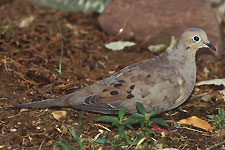Local Wildlife
Mourning Dove

Scientific Name: Zenaida macroura
Audio: Listen Now
Photo Source: Kevin T. Karlson
Audio Source: Cornell Lab of Ornithology
More Info.: Univ. of Michigan
The mourning dove is a medium-sized bird of the pigeon family. They have a small head, long, pointed tail, thin bill, and red legs and feet. In general, their overall color is a gray-blue to gray-brown with black spots on their wings and white tips on their tail. However, the coloration of each individual may vary significantly with males having slightly brighter coloring. Though they can be found in virtually all areas of Sunriver, they are most often seen in areas with cones, seeding plants, and other food sources.
Highly adaptable, these birds can be found in a wide variety of habitats ranging from suburban areas to open woodlands and forest edges near grasslands. In woodlands and grasslands, their diet is primarily comprised of various plant seeds. Though they prefer to eat while on the ground, they will eat in trees and bushes if ground foods are scarce. They may also eat ants, beetles, and grasshoppers if other food sources are severely limited.
Mourning doves are monogamous and often remain together throughout a winter season. Once mating has taken place, the male seeks a nest site and both begin building a nest. A clutch is commonly two, small eggs which are incubated for approximately two weeks. During the first two weeks of life, the young remain in the nest and are primarily cared for by the female. After that, the young leave the nest, but often remain nearby where the male takes over their care.
Mourning doves use a variety of body displays to scare away intruders, threaten invading males, and attract potential mates. They may also use the "broken-wing feign" (more commonly associated with the killdeer) to lure predators away from nesting sites. Songs and calls are used to communicate with each other.
